Happy anniversary to Dümmen Orange!
Watch our videos!
Dümmen Orange
Sakata
Kientzler
Chris: Greetings and salutations, plant fans, and welcome to Day 3 of our California Spring Trials (CAST) coverage. Today is the three-fifths point in our journey together; we start out in the central coast town of San Louis Obispo visiting Dümmen Orange, then drive north a couple of hours to the Monterey Bay area and Salinas, home of Sakata and Kientzler. Sounds easy, but we saw a lot ... so let me dive right in by saying Happy 25th anniversary to Dümmen Orange North America! They did a nice job organizing their event, which was held in the lovely venue of Center of Effort Winery. A nice trial all the way around, eh, Bill?
Bill: The organization and focus at Dümmen—especially with annuals—was on point and made it easy for us to spot the highlights. Just inside the door (be sure to watch the VIDEO) we were stopped in our tracks by two new dahlias launched for 2026 and no doubt kicking off a new series called Summer Bees. Red and Purple are the first colors and understate the MASSIVE bicolor blooms. They were impressive in large patio pots, but can be produced in gallons for wholesale. You’ve got to check these out! The huge blooms also attract plenty of pollinators.

Chris: I loved ‘em! I also love their I’Conia interspecific begonias—big, vigorous and colorful. New is I’Conia Bacio Lemon. Bacio is the most compact of their three collections with loads of flowers. Lemon is a peachy yellow, not a bright or pure yellow. It contrasts nicely against the dark green foliage.
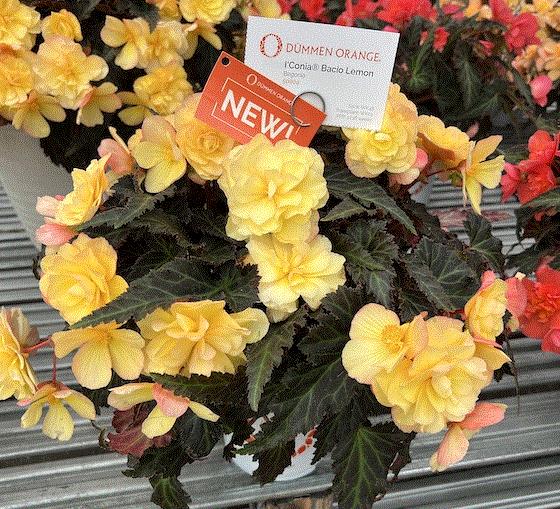
In the Big EZEE interspecific geranium series, there’s a new one called Pink Panther. The color is a bit more neon than the famous cat’s fur. Big EZEE is known for having big flower umbels while being easy to grow.
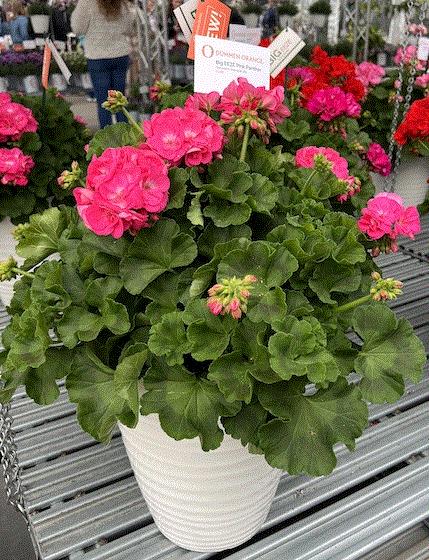
Bill: One of my picks of the trials so far was a new calibrachoa in Dümmen’s Rainbow (trailing) series called Dragon Berry. The blooms are pink to purple and sort of multicolor with shades coming as temperature impacts the flower buds.
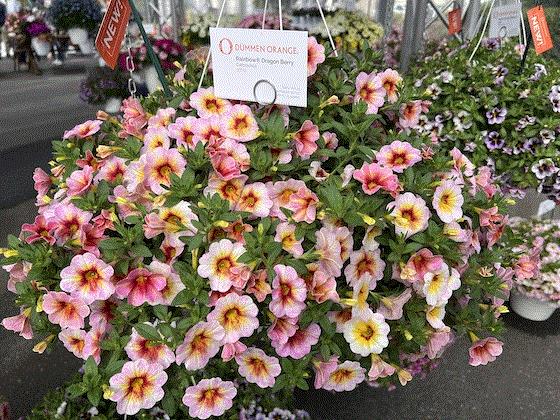
Chris: Wonder what’s with all the “dragon” color names this year ...? We’ll have to get to the bottom of that. Anyway, you can’t talk Dümmen annuals without talking Confetti Gardens, their patented combination of multiple genera rooted in the same liner. They’ve got scores of combinations and added a few more this year, no doubt featuring some of their new genetics. But what I liked was an idea they showed of what you might call “deconstructed” Confetti Gardens: the individual varieties offered in 306 packs so the gardener can make her own Confetti at home.

Bill: Chris opened with a shout out to Dümmen’s 25th anniversary of their North American office and part of the trial space was set up with a long party table, complete with decorations and big combo pots. The mixes included were all part of Garden Party—a combo recipe program. New for 2026 are “garden parties” that combine both annuals and perennials called Bloomix. There’s no reason both can’t play together in a big pot, because with different colors, textures and habits, they make for a fun party.

Dümmen is also about perennials
Chris: On to perennials, which are becoming so important to the company. And there are a lot of new ones—maybe more than there were annuals! And they did a good job categorizing many of them into three categories: Early Season, True North and First-Year Flowering.
Bill: I’ll start the perennial parade in the first-year flowering group with Leucanthemum Sweet Daisy Kylie, a daisy with massive white flowers. The species name is L. maximum, which was new to us, but certainly described the palm-sized blooms.
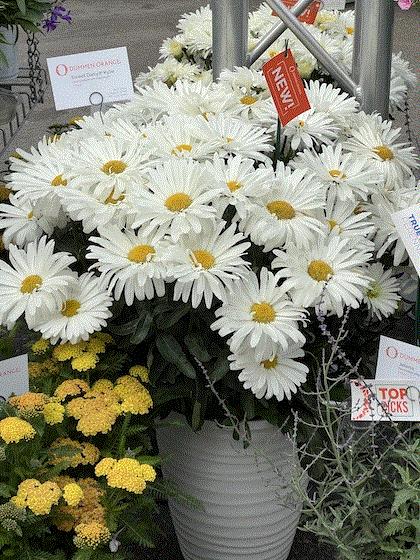
Another first-year perennial that stood out was Campanula Ultra Violet, which would make a great rock garden or alpine plant with vibrant purple flowers. Campanula is a new genus to Dümmen, but not the only new one in the trial.
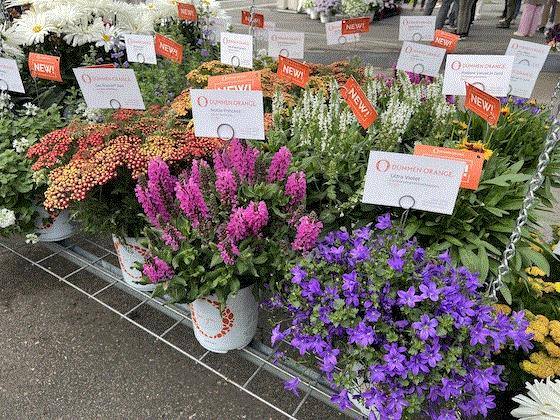
Nepeta and sedum are also new to the company and both debut with new series. Nepeta Serene White and Lilac are compact, but upright, with excellent drought tolerance. The new sedums are also bred for compactness and the benefits include much safer shipping without the risk of stems snapping, as well as mildew resistance. Sedum Cloudburst Burgundy and Green Flash are nice and tidy when young and retain a full, but compact, size in the garden. They’d work great in front of Sedum Autumn Joy, we were told. We all really liked them.

Chris: A couple more for the first-year-flowering category are Achillea Sea Breeze, bred for big, full flowers, while retaining the drought tolerance the genus is known for. Sea Breeze gets Red and Salmon. And their Salvia nemarosa Noble Knight gets a bright pink sister, Noble Princess. Like most girls, she’s just a tad later than the boy.
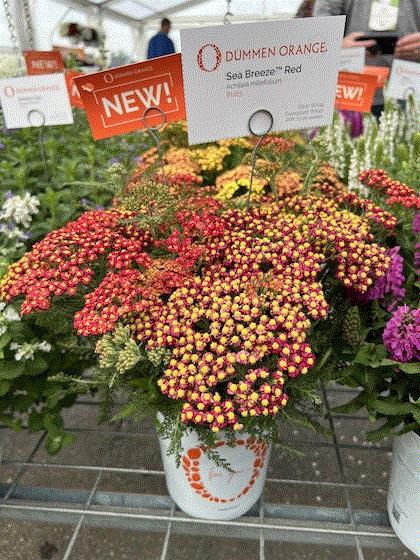
Bill: Moving from first-year flowering to more traditional perennials, but for early season sales, Dümmen introduced their first violas for 2026—a seven-color series called Spring Morning. As a Zone-5 perennial, these violas will bloom in spring and then come back into flower for fall. They’ve shown good heat and humidity tolerance in trials and include more than just blue tones, with plenty of yellow, white and dark purple tones. The color range is more similar to annual pansies than traditional perennial violas.
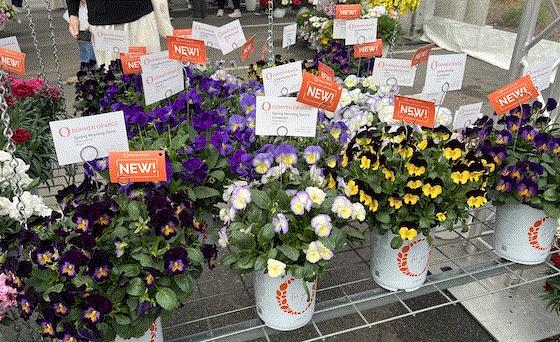
Also for early in the season, a couple new dianthus—a new series and a series that’s been available in Europe and has made its way across the pond. Dianthus Sprint comes to us after three years in Europe. It’s compact, but programmable, to hit all the major gift-giving spring holidays. Sprint comes in nine colors. The domestic production of cuttings is in Encinitas, California. More vigorous than Sprint is Arabella, an all-new series with traditional carnation blooms in three colors.
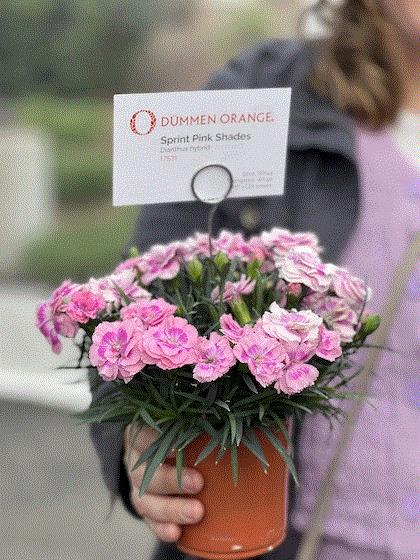
Chris: And, Bill, if you need an early season groundcover for the shade, you could do no better than Saxifraga Scenic Pink and Scenic Appleblossom.
Bill: I’ll keep that in mind! Now on to extreme hardiness. I joked in our video that Dümmen’s True North perennial group is trialed for cold hardiness on glaciers, but the grounds are actually near Fargo, North Dakota—still plenty cold to prove Zone 3 survival.
New for True North are a couple beautiful Phlox Flames—Blue Ice, with a cool deep magenta eye in the center of large, purple-blue flowers; and Early Pink Pinwheel, with a unique bicolor pattern. We were told that Pink Pinwheel is as much as four weeks earlier than competitive varieties, which should make perennials growers happy.
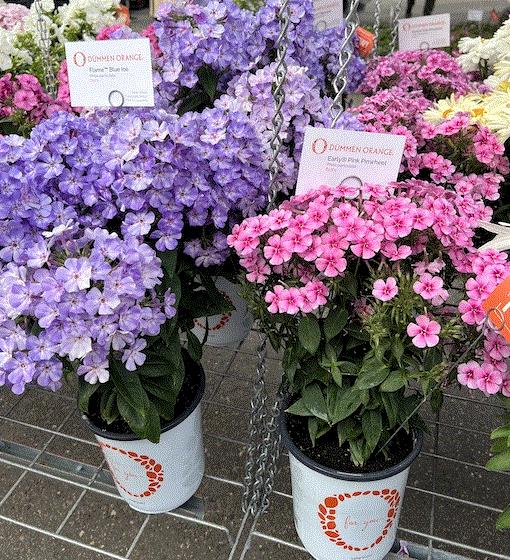
Chris: We’ve saved the best perennials for last: Dümmen’s impressive lavenders. I don’t know if you can find lavender plants with showier spikes and bracts (the two parts of the flowers that provide all the color) than theirs. Among the introductions, the most showy award goes to their Spanish (L. stoechas) La Diva collection, which gets two additions: La Diva Berry Rosey (rose-pink) and Berry Bountiful (purple). They look equally good in pots and baskets.
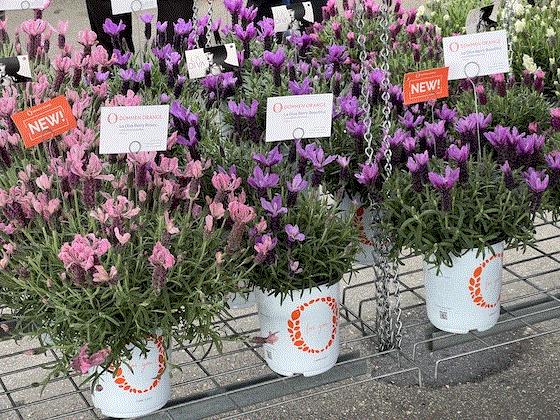
See these colorful intros and much, much more in our VIDEO TOUR OF DÜMMEN.
Alrighty then, time for that long drive north to Sakata ...

More anniversaries at Sakata
Bill: Sakata is always a bountiful trial because we get to see excellent flowers and veggies and a few series that are incredibly important to our industry. In fact, two of these were celebrating major anniversaries this year: Majestic Giants Pansies and SunPatiens interspecific impatiens.
Chris: Sakata’s No. 1 annual, SunPatiens, turns 20 this year! It was way back in 2005 when SunPatiens launched at the Cannes Film Festival, after eight years of breeding with germplasm that originated in Indonesia. It was launched to the industry in 2006. I wonder how many colors there were?
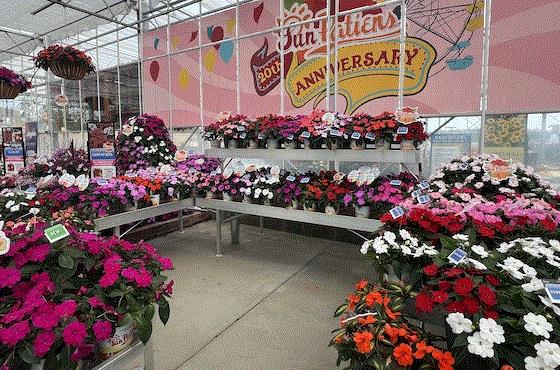
But it was 41 years before that—1965—when Sakata launched Majestic Giants Pansies, the first F1 pansy series and still one of the best-known flower varieties on the market. They’re still the largest-flowered series available, too. There may be more modern pansies available from Sakata and others, but none are more respected. Happy 60th to Majestic Giants!
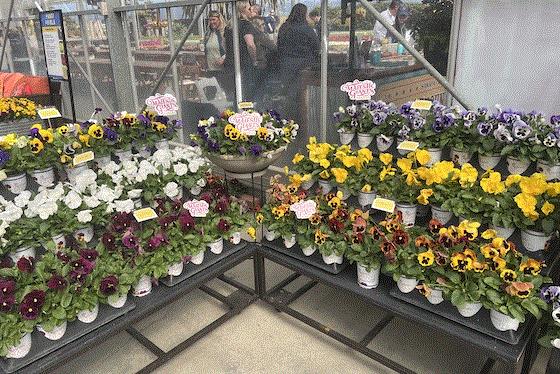
Alas, there were no new MGs with which to celebrate, but there was a new ColorMax Viola, Lavender Flash, plus some mixes. Oh, they also also launched a mix called Enchantment that features two Grandio Pansies and one ColorMax Viola—maybe the first time the two have been combined.

Bill: You get Majestics, so I’ll take SunPatiens—which I consider an honor. Twenty years is a long run and Sakata isn’t resting on their laurels, offering a fantastic new color in the compact assortment, as well as an improvement. New Pink Flash continues the trend we’ve been seeing in soft pink blooms and it’s a bicolor, to boot. The improved for 2026 is Royal Magenta, which disappeared for a couple of years due to some issues with the parent lines, but is back and better than ever.

Chris: Petchoa, Bill.
Bill: Gesundheit.
Chris: No, no, Petchoa. That’s what the SuperCal Petunias really are—a cross between petunia and calibrachoa, giving you durability, weather resistance (rain, cold and heat) and great colors you can’t find in regular petunias. There are two types: traditional (spreading) and premium (mounded). Premiums get two new colors: Coral Star and Yellow Sun Improved; while traditional gets Blue Eyed Rose.

Bill: A few more new intros from Sakata include Calibrachoa Calipetite Pink Splash, Gerbera Majorette Orchid Dark Eye, Celosia Flamma Pink and two vegetative coleus in the Partytime series, Royal Red and Crimson. Bossman, have I missed anything?
Chris: Snapdragon Candy Tops Champagne (with flowers that look just like popcorn) and Primula Lighthouse Scarlet, a P. polyanthus type with erect umbels of rich red flowers.
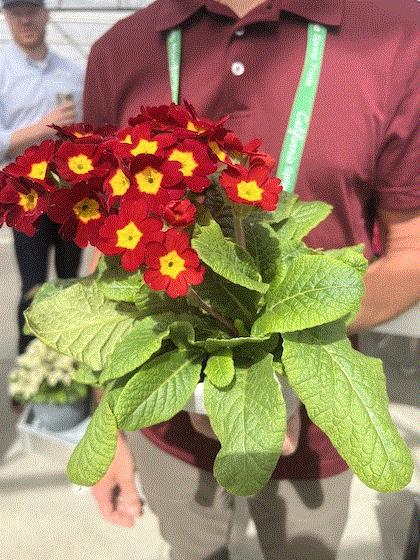
Bill: Sakata had plenty of new intros across a bunch of different series, so I’m not surprised I missed a couple. HERE’S WHERE YOU CAN FIND THE SAKATA VIDEO.
Chris, why don’t you lead us into the other section of the greenhouse where Kientzler has borrowed some space and let our dear readers know about a major announcement Steve Rheinhart shared?

New digs and new varieties from Kientzler
Chris: They would have read about this in my Acres Online newsletter a couple weeks ago: Kientzler is building a new farm in Central America—Guatemala, to be precise—to complement their existing farm in Costa Rica. It’s actually an existing greenhouse they’re upgrading; they’ll start producing this fall for sales next year. The reason? Increased production capability and better labor availability (there’s increasingly more competition for staff in Costa Rica).
Bill: And with the expanded production space Kientzler is going to have plenty of room for more crops like the new bracteantha and bidens they showed us. The newest strawflowers on the market are in their Sunbrero series, which are more compact than competitive genetics and launch with five colors—Orange, Pink, Red, White and Yellow.
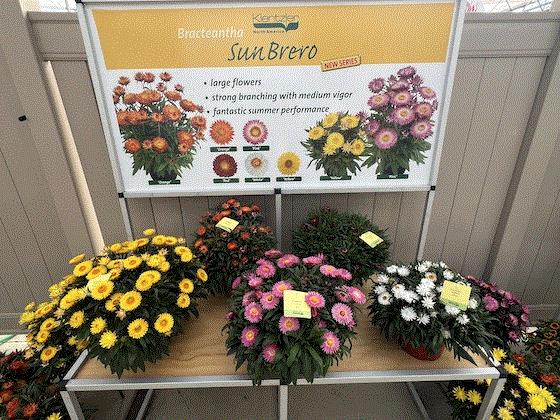
Chris: That’s a great name! I’m surprised nobody has come up with that before.
Bill: Yup! When it comes to bidens, Kientzler continues to breed and improve for habit and flower size and in 2026 will have three new ones to offer in the basket type called Bee. Bee Superstar and Bee Pink Buzz is a color breakthrough according to Steve Rinehart as a magenta-pink bidens, and Spicy Electric White (below) is technically an improvement, but the huge yellow-and-white blooms sure looked fresh and new to me. It must be a major improvement.
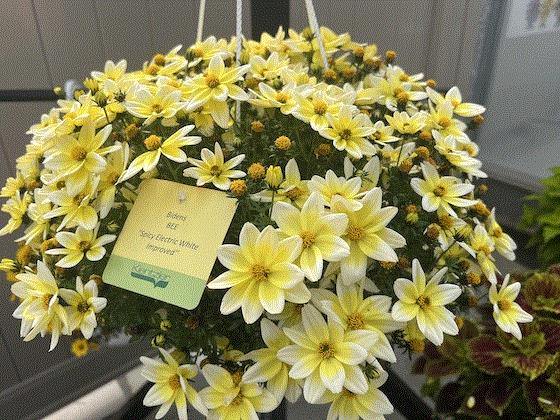
Chris: The biggest and most impressive plants in the Kientzler display had to be those Terrascape Coleus in the back, eh? Big and bold! Their upright collection gets three new colors: Midnight Majesty, Pink Ribbons and Royal Delight. And the mounding/trailing collection gets the interestingly named All That Lava.

Bill: A few more intros from Kientzler included a red calibrachoa with a peachy rim and yellow throat named Sangria Fizz that’s part of the Unique series of mounding types; another Sangria in the Osteospermum Summer Smile series; and two cute little Delosperma Sun Diamonds—Rose and Red.
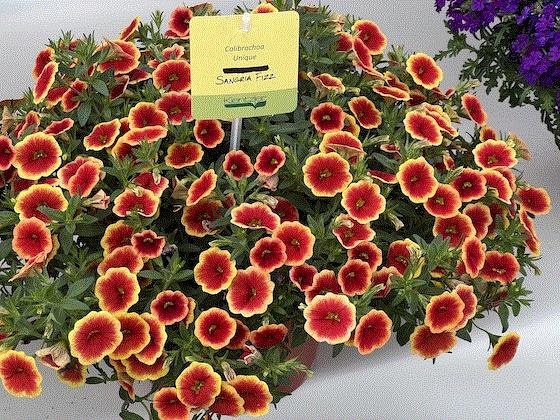
We also saw our third new saxifraga series (that’s one each day for those of you keeping count). Kientzler’s gets the best name award: So Saxy. It includes Appleblossom, White and Dark Rose.

See So Saxy and all the rest of Kientzler’s new intros in OUR VIDEO FROM THE TRIAL.

Heading north tomorrow ... Be sure to watch our videos!
Chris: Whew! It was exhausting to do and exhausting to relive! But we’re having fun—how could you not, looking at flowers for a living? We’re all still friends despite spending 18 hours a day together arguing over whether it’s pink or magenta, and the proper pronounciation of “stoechas.” And we’re cranking out the content, eh, young William?
Bill: Yeah, we are. We’re up to 17 videos with more than 3,000 views and that’s probably your best bet if you want to see all these new varieties in all their 4K splendor—here’s A LINK TO THE RAPIDLY EXPANDING CAST 2025 PLAYLIST. For pics of many of the plants we’ve seen, check out our INSTAGRAM @growertalksgreenprofit and FACEBOOK posts. And before we hit send tonight, I’ll take this opportunity to ask you to follow our pages and comment, like and share the posts (and subscribe to the GrowerTalks YouTube channel) so you don’t miss all the good information and some of our good-natured shenanigans.
Chris: Tomorrow (Friday), we have our busiest day: three stops: American Takii, Danziger and Syngenta. All three produce world-class genetics, so be sure to tune in to see what we find!






See you tomorrow!
Chris, Jen, Bill & Osvaldo
Chris Beytes
Editor-in-Chief
GrowerTalks/Green Profit
Jen Zurko
Editor
GrowerTalks/Green Profit
Bill Calkins
Senior Editor/Digital Editor
GrowerTalks/Green Profit
Osvaldo Cuevas
Video Producer
GrowerTalks/Green Profit
This email received by 31,684 lucky folks, and you're one of them!
Want to be one of the lucky sponsors who reach those 31,751 readers of Acres of Buzz from Spring Trials? Drop Paul Black a line and he'll tell you what a bargain it is!